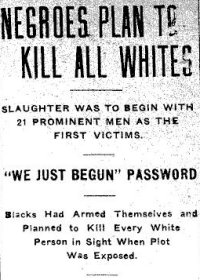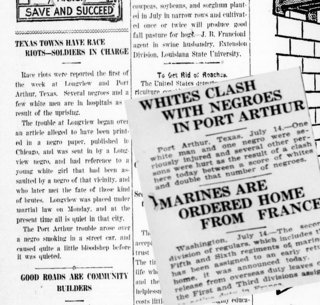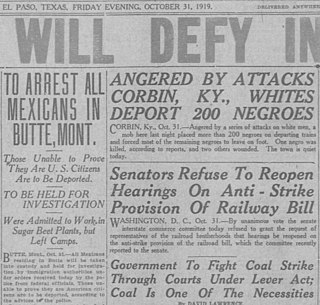In the broader context of racism in the United States, mass racial violence in the United States consists of ethnic conflicts and race riots, along with such events as:

The city of Harrison is the county seat of Boone County, Arkansas, United States. It is named after Marcus LaRue Harrison, a surveyor who laid out the city along Crooked Creek at Stifler Springs. According to 2019 Census Bureau estimates, the population of the city was 13,069, up from 12,943 at the 2010 census and it is the 30th largest city in Arkansas based on official 2019 estimates from the U.S. Census Bureau. Harrison is the principal city of the Harrison Micropolitan Statistical Area, which includes all of Boone and Newton counties.

Bonanza is a city in Sebastian County, Arkansas, United States. It is part of the Fort Smith, Arkansas-Oklahoma Metropolitan Statistical Area. At the 2010 Census, the population of Bonanza was 575. According to the 2018 US Census Bureau estimates, the population of Bonanza was 564. Bonanza began as a coal mining town of the Central Coal and Coke Company.

Monett is the most-populous city in Barry and Lawrence counties in the U.S. state of Missouri. The city is located in the Ozarks, just south of Interstate 44 between Joplin and Springfield. According to the 2020 census, the population of the town was estimated to be 9,576 individuals.

The Elaine massacre occurred on September 30 – October 2, 1919, at Hoop Spur in the vicinity of Elaine in rural Phillips County, Arkansas where African Americans were organizing against peonage and abuses in tenant farming. As many as several hundred African Americans and five white men were killed. Estimates of deaths made in the immediate aftermath of the Elaine Massacre by eyewitnesses range from 50 to "more than a hundred". Walter Francis White, an NAACP attorney who visited Elaine shortly after the incident, stated "... twenty-five Negroes killed, although some place the Negro fatalities as high as one hundred". More recent estimates in the 21st century of the number of black people killed during this violence are higher than estimates provided by the eyewitnesses, and have ranged into the hundreds. The white mobs were aided by federal troops and local terrorist organizations. Gov. Brough led a contingent of 583 US soldiers from Camp Pike, with a 12-gun machine gun battalion.
Sundown towns, also known as sunset towns, gray towns, or sundowner towns, are all-white municipalities or neighborhoods in the United States. They are considered towns that practiced or still practice a form of racial segregation by excluding non-whites via some combination of discriminatory local laws, intimidation or violence. They were most prevalent before the 1950s. The term came into use because of signs that directed "colored people" to leave town by sundown.

Red Summer was a period in mid-1919 during which white supremacist terrorism and racial riots occurred in more than three dozen cities across the United States, and in one rural county in Arkansas. The term "Red Summer" was coined by civil rights activist and author James Weldon Johnson, who had been employed as a field secretary by the National Association for the Advancement of Colored People (NAACP) since 1916. In 1919, he organized peaceful protests against the racial violence.

Calvert City is a home rule-class city in Marshall County, Kentucky, United States. The population was 2,514 at the 2020 census.
The Camilla massacre took place in Camilla, Georgia, on Saturday, September 19, 1868. African Americans had been given the right to vote in Georgia's 1868 state constitution, which had passed in April, and in the months that followed, whites across the state used violence to combat their newfound political strength, often through the newly founded Ku Klux Klan. Georgia agents of the Freedmen’s Bureau recorded 336 cases of murder or assault with intent to kill against freedmen from January 1 through November 15.

The Battle of Virden, also known as the Virden Mine Riot and Virden Massacre, was a labor union conflict and a racial conflict in central Illinois that occurred on October 12, 1898. After a United Mine Workers of America local struck a mine in Virden, Illinois, the Chicago-Virden Coal Company hired armed detectives or security guards to accompany African-American strikebreakers to start production again. An armed conflict broke out when the train carrying these men arrived at Virden. Strikers were also armed: a total of five detective/security guards and eight striking mine workers were killed, with five guards and more than thirty miners wounded. In addition, at least one black strikebreaker on the train was wounded. The engineer was shot in the arm. This was one of several fatal conflicts in the area at the turn of the century that reflected both labor union tension and racial violence. Virden, at this point, became a sundown town, and most black miners were expelled from Macoupin County.

The Negro Motorist Green Book was a guidebook for African American roadtrippers. It was founded by Victor Hugo Green, an African American, New York City postal worker who published it annually from 1936 to 1966. This was during the era of Jim Crow laws, when open and often legally prescribed discrimination against African Americans especially and other non-whites was widespread. While pervasive racial discrimination and poverty limited black car ownership, the emerging African American middle class bought automobiles as soon as they could but faced a variety of dangers and inconveniences along the road, from refusal of food and lodging to arbitrary arrest. In the South, these dangers were particularly severe, where Black motorists risked harassment, physical violence, or even murder for minor infractions or for being in predominantly white areas. In some cases, African American travelers who got lost or sought lodging off the beaten path were killed, with little to no investigation by local authorities. In response, Green wrote his guide to services and places relatively friendly to African Americans. Eventually, he also founded a travel agency.

Berry Washington was a 72-year-old black man who was lynched in Milan, Georgia, in 1919. He was in jail after killing a white man who was attacking two young girls. He was taken from jail and lynched by a mob.

The Johnson–Jeffries riots refer to the dozens of race riots that occurred throughout the United States after African-American boxer Jack Johnson defeated white boxer James J. Jeffries in a boxing match termed the "Fight of the Century". Johnson became the first black World Heavyweight champion in 1908 which made him unpopular with the predominantly white American boxing audiences. Jeffries, a former heavyweight champion came out of retirement to fight Johnson and was nicknamed the "Great White Hope". After Johnson defeated Jeffries on July 4, 1910, many white people felt humiliated and began attacking black people who were celebrating Johnson's victory.
Howell is a neighborhood of Evansville, Indiana, United States.

The Port Arthur riot happened on July 15, 1919, in Port Arthur, Texas. Violence started after a group of white men objected to an African American smoking near a white woman on a street car. A "score" of whites and twice that number of African Americans battled in the streets leaving two seriously injured and dozens with minor injuries.

Corbin, Kentucky race riot of 1919 was a race riot in 1919 in which a white mob forced nearly all the town's 200 black residents onto a freight train out of town, and a sundown town policy until the late 20th century.

African-American man, Jordan Jameson was lynched on November 11, 1919, in the town square of Magnolia, Columbia County, Arkansas. A large white mob seized Jameson after he allegedly shot the local sheriff. They tied him to a stake and burned him alive.













